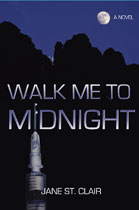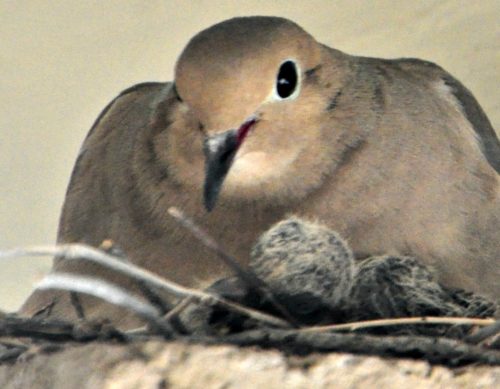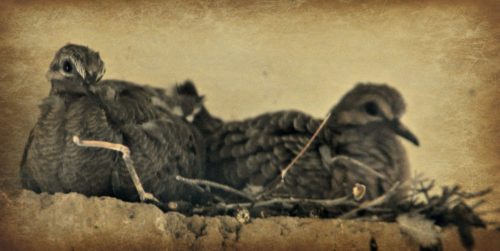by Jane St. Clair
Tucson, Arizona … A long time ago a mourning dove nested in a Mexican pot in our backyard, but the dog got jealous of my attention to her, overturned the pot and ate her eggs.
So I was very happy that I finally got to make friends with a new mourning dove mama. This time she built a flimsy little stick nest on top of a brick tower just outside my kitchen window. Although she was very close to the house, I was determined not to disturb her. I had to take pictures through a window that has a dirt film, but I figured if I cleaned it, she’d fly away.
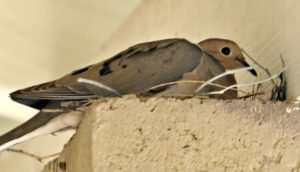 I never really got the phrase “sitting on her eggs” until I watched this mama mourning dove. She sat and sat and sat. For weeks on end.
I never really got the phrase “sitting on her eggs” until I watched this mama mourning dove. She sat and sat and sat. For weeks on end.
She rarely changed position or even moved her strange little head and staring beady eyes. No wonder we get the word “brooding” from bird behavior. This bird sat sitting and staring and brooding for so long she put any brooding hormonal teenager to shame. She could even give famous brooding people like Lord Byron and Dracula a run for their money.
One day I realized that she was sitting on a different kind of chair, one that was more elevated.
And it was true! The eggs had hatched! I could see two little feathered heads.
But nothing much changed. She never left the nest, just sat there, keeping them warm, even though the temperature outside was in the 100s. Occasionally I could get a peek at her two babies, born helpless and unable to move on their own. They were not twins, for one was bigger and stronger.

In their dorky dependence on Mama and their fearful little ways, they were adorable. The first few days Mama provided a form of milk, as mourning doves are among the few kinds of birds that can do that.
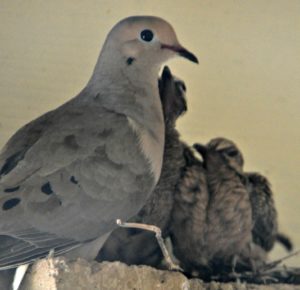 The babies quickly grew into teenagers, and she began to leave them alone and come back with real food.I was amazed at how much work she put into this, especially after the time spent brooding.
The babies quickly grew into teenagers, and she began to leave them alone and come back with real food.I was amazed at how much work she put into this, especially after the time spent brooding.
One morning the bigger baby was no longer in the nest. I slowly opened the front door to check on him, and he was hopping on the ground.
I thought about putting him back up there with his sister, but I decided this little fellow was a daring soul who wanted his own way in life. I named him “the Red Baron” and wished him luck.

That afternoon his sister tried the same risky maneuver and died in the fall. I cried for her and felt sorry for her faithful selfless mother. It seemed so sad that after all this love and effort, my bird mama had lost a chick.
Mama mourning dove left and never came back. I didn’t blame her. I like to think that the Red Baron made it and was somewhere out there, pecking the desert ground in sunlight and flying around cactus in moonlight.
The abandoned nest of sticks reminded me of how much I missed the little family. Then, a week later, I pulled 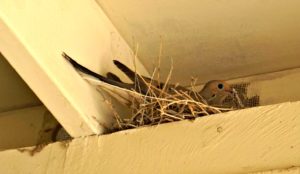 into the car port and there she was. She had built a new nest in a better place, one with a solid roof and walls around it, up there in the rafters of the garage. What’s more, she didn’t have to put up with paparazzi like me taking pictures. It was perfect for her.
into the car port and there she was. She had built a new nest in a better place, one with a solid roof and walls around it, up there in the rafters of the garage. What’s more, she didn’t have to put up with paparazzi like me taking pictures. It was perfect for her.
Godspeed, dove-mama. May all your chicks make it to desert sunlight.
“Disneyland Death,” a story by Jane St. Clair is now available for reading online in the Spring 2018 PDF issue here at Medical Literary Messenger from Virginia Commonwealth University. Negative Capability Press accepted Jane St. Clair’s short story, “The Gerber Secret.” It will appear in the July 2018 issue under the theme of “Family Secrets.”

